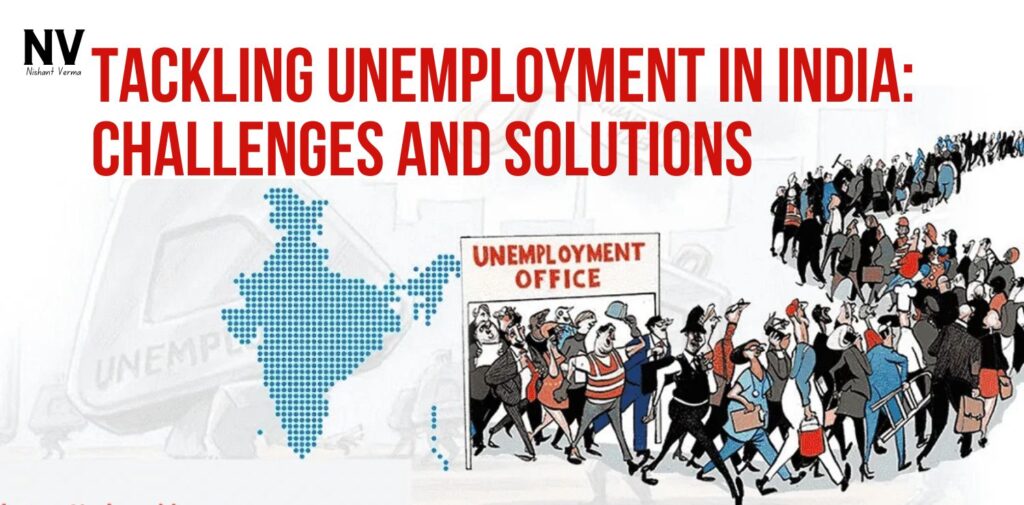Unemployment is one of the most pressing challenges facing India today. Despite being one of the fastest-growing economies in the world, India struggles with high unemployment rates, particularly among young people. The lack of adequate job opportunities not only hampers economic growth but also exacerbates social inequalities, fueling frustration and discontent. Understanding the causes of unemployment and exploring potential solutions is critical to building a more inclusive and prosperous India.

Causes of Unemployment in India
- Skill Mismatch: One of the primary reasons for unemployment in India is the mismatch between the skills possessed by job seekers and the skills required by employers. Many graduates, particularly from rural and semi-urban areas, lack the technical or vocational skills necessary to compete in the modern job market. This skills gap leaves many young people underemployed or unemployed, even as industries face a shortage of qualified workers.
- Overdependence on Agriculture: Despite contributing only about 15% of India’s GDP, agriculture still employs nearly half of the country’s workforce. This overdependence on agriculture, combined with the sector’s low productivity, means that many people remain underemployed. The lack of opportunities in rural areas often forces people to migrate to cities in search of work, where they may face unemployment or precarious jobs in the informal sector.
- Slow Growth of the Manufacturing Sector: India’s manufacturing sector has not grown at the rate needed to absorb the millions of young people entering the workforce each year. While sectors like information technology (IT) and services have seen robust growth, manufacturing—which has the potential to create large-scale employment—has lagged. Factors like inadequate infrastructure, labor market rigidity, and complex regulations have stifled the sector’s growth, limiting its ability to generate jobs.
- Technological Disruption: The rise of automation and artificial intelligence (AI) is also contributing to unemployment in certain sectors. Low-skilled jobs, particularly in manufacturing and services, are increasingly being replaced by machines. This trend is expected to continue, creating further challenges for low-skilled workers who are unable to adapt to the new technological landscape.
- Population Growth: India’s rapidly growing population adds to the unemployment problem. Each year, millions of young people enter the labor force, but the economy is unable to create jobs at the same pace. This leads to a high level of competition for a limited number of positions, leaving many qualified candidates without work.

Solutions to Address Unemployment
- Improving Education and Skill Development: One of the most critical steps in tackling unemployment is addressing the skills gap. The government, in partnership with the private sector, must focus on improving the quality of education and expanding vocational training programs. Initiatives like Skill India and Pradhan Mantri Kaushal Vikas Yojana (PMKVY) aim to provide skill development training to millions of young people, equipping them with the competencies needed to compete in the modern job market.
- Boosting the Manufacturing Sector: Reviving and expanding the manufacturing sector is essential for job creation. The government’s Make in India initiative seeks to boost manufacturing by encouraging both domestic and foreign investment. However, to truly make an impact, the government must address the challenges faced by the sector, including improving infrastructure, simplifying regulations, and promoting labor reforms.
- Encouraging Entrepreneurship and Startups: Encouraging entrepreneurship can play a significant role in generating employment. The government has launched several initiatives, such as Startup India and Stand-Up India, to promote the growth of startups and small businesses. By providing easier access to credit, mentorship, and infrastructure, these programs aim to foster innovation and create jobs, particularly in sectors like technology, manufacturing, and services.
- Investing in Infrastructure Development: Infrastructure development has the potential to create a large number of jobs in both urban and rural areas. By investing in the construction of roads, bridges, railways, and housing, the government can not only boost employment but also create long-term assets that promote economic growth.In rural areas, infrastructure development projects can reduce migration to cities by improving access to markets, healthcare, and education, thereby providing more sustainable employment opportunities in agriculture and small industries.
- Promoting the Informal Sector: A significant portion of India’s workforce is employed in the informal sector, which includes jobs in construction, retail, and services. While these jobs are often low-paying and lack social security benefits, the informal sector plays a crucial role in providing employment for millions of people. By formalizing parts of the informal economy, providing social security benefits, and improving working conditions, the government can improve the livelihoods of workers in this sector.
- Leveraging Technology for Job Creation: While technology can displace certain jobs, it can also be leveraged to create new opportunities. The rise of the gig economy, driven by digital platforms like Uber, Swiggy, and Zomato, has created jobs in sectors like transportation and delivery services. Encouraging the growth of the gig economy, while ensuring fair wages and social security for gig workers, can help address unemployment in urban areas.
- Reducing Population Growth: Addressing population growth is another key factor in reducing unemployment. Effective family planning programs, along with efforts to promote women’s education and employment, can help slow the population growth rate. A smaller population with better access to education and resources will ease the pressure on the job market.

Conclusion
Unemployment in India is a multifaceted issue that requires a comprehensive approach. Solutions like improving education and skill development, boosting the manufacturing sector, encouraging entrepreneurship, and investing in infrastructure can help create jobs and reduce unemployment. By addressing both the immediate and structural causes of unemployment, India can pave the way for a more prosperous future, where all citizens have the opportunity to participate in and benefit from the country’s economic growth.




